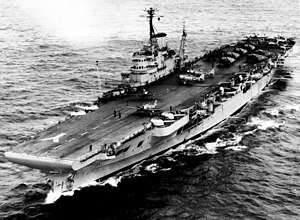
Back HMS Illustrious Afrikaans HMS Illustrious (87) Catalan Illustrious (Schiff, 1940) German HMS Illustrious (R87) Spanish HMS Illustrious (87) Basque اچاماس الیوستریوس (۸۷) Persian HMS Illustrious (87) Finnish HMS Illustrious (R87) French HMS Illustrious (R87) Croatian HMS Illustrious (87) ID
 Illustrious circa 1954
| |
| History | |
|---|---|
| Name | Illustrious |
| Ordered | 13 April 1937 |
| Builder | Vickers-Armstrongs |
| Laid down | 27 April 1937 |
| Launched | 5 April 1939 |
| Commissioned | 25 May 1940 |
| Decommissioned | February 1955 |
| Identification | Pennant number: 87[2] |
| Motto |
|
| Honours and awards |
|
| Fate | Sold for scrap, November 1956 |
| Badge | In front of a trumpet erect two trumpets in saltire gold[3] |
| General characteristics (as built) | |
| Class and type | Illustrious-class aircraft carrier |
| Displacement | 23,000 long tons (23,369 t) (standard) |
| Length | |
| Beam | 95 ft 9 in (29.2 m) |
| Draught | 28 ft 10 in (8.8 m) (deep load) |
| Installed power |
|
| Propulsion |
|
| Speed | 30 knots (56 km/h; 35 mph) |
| Range | 10,700 nmi (19,800 km; 12,300 mi) at 10 knots (19 km/h; 12 mph) |
| Complement | 1,299 |
| Sensors and processing systems | 1 × Type 79 early-warning radar |
| Armament |
|
| Armour |
|
| Aircraft carried | 36 |
| Aviation facilities | 1 catapult |
HMS Illustrious was the lead ship of her class of aircraft carriers built for the Royal Navy before World War II. Her first assignment after completion and working up was with the Mediterranean Fleet, in which her aircraft's most notable achievement was sinking one Italian battleship and badly damaging two others during the Battle of Taranto in late 1940. Two months later the carrier was crippled by German dive bombers and was repaired in the United States. After sustaining damage on the voyage home in late 1941 by a collision with her sister ship Formidable, Illustrious was sent to the Indian Ocean in early 1942 to support the invasion of Vichy French Madagascar (Operation Ironclad). After returning home in early 1943, the ship was given a lengthy refit and briefly assigned to the Home Fleet. She was transferred to Force H for the Battle of Salerno in mid-1943 and then rejoined the Eastern Fleet in the Indian Ocean at the beginning of 1944. Her aircraft attacked several targets in the Japanese-occupied Dutch East Indies over the following year before Illustrious was transferred to the newly formed British Pacific Fleet (BPF). The carrier participated in the early stages of the Battle of Okinawa until mechanical defects arising from accumulated battle damage became so severe she was ordered home early for repairs in May 1945.
The war ended while she was in the dockyard and the Admiralty decided to modify her for use as the Home Fleet's trials and training carrier. In this role she conducted the deck-landing trials for most of the British post-war naval aircraft in the early 1950s. She was occasionally used to ferry troops and aircraft to and from foreign deployments as well as participating in exercises. In 1951, she helped to transport troops to quell rioting in Cyprus after the collapse of the Anglo-Egyptian treaty of 1936. She was paid off in early 1955 and sold for scrap in late 1956.